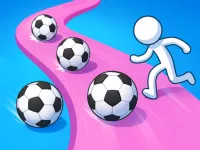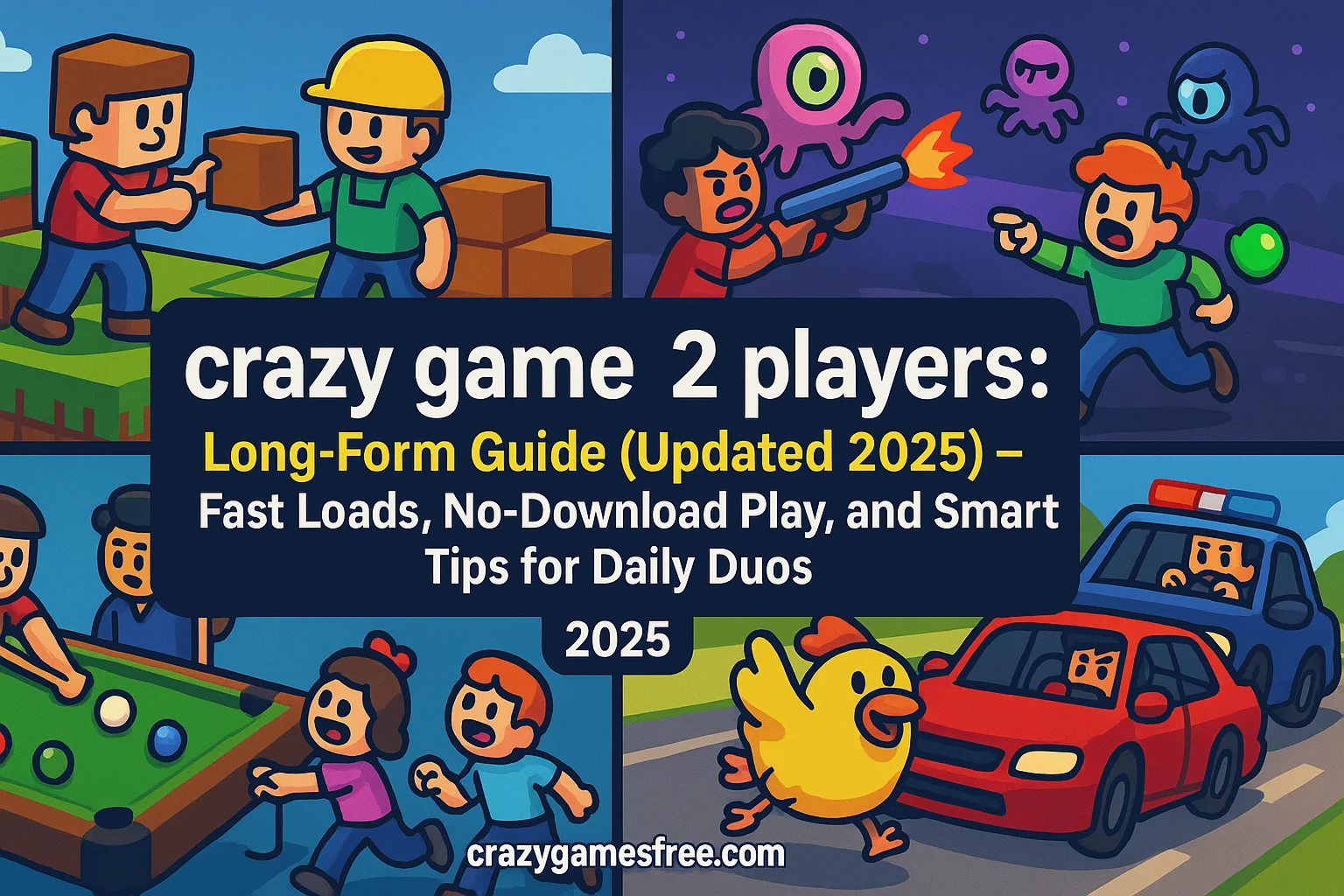
Crazy Kick Ball

Obby: Working as a Firefighter

Obby: Dig to the center of the Earth

Noob vs Pro But Floor is Lava Minecraft

Rogue Runner

Neon Ball Slope

Xtreme Good And Bad Boys 2 2025

FRAGMENT

Tralalero Tralala Endless Run

Feed Monster Game

Sky Bus Mega Ramp Drive

Arrow Survival: 15 Seconds

Minecraft Unblocked Online

Dead Zone15165

Apple Worm 2

Two players, one keyboard (or two controllers), zero downloads—that’s the vibe. crazy game 2 players covers any browser title built for quick head-to-head or chill co-op sessions you can launch in seconds. No accounts, no installs, just load in and start learning a tight little loop together: pick a mode, master the inputs, iterate faster than your friend can trash-talk. Whether you’re on a school Chromebook, a work laptop, or a half-asleep desktop, you can squeeze in a best-of-three between meetings or grind a longer run after hours.
If you want a clean place to jump in right now, Start crazy game 2 players instantly and pick a duo that fits your mood—sports, builders, shooters, or puzzle duels.
Here’s the plain-English read: two-player browser games split into two flavors.
Local two-player (a.k.a. “couch co-op/versus”): both of you share the same device and play with different keys or controllers. These shine for instant rematches and zero latency.
Online multiplayer (2P modes): you each play on your own device, sometimes in private lobbies, sometimes quick-match. Expect more setup than local, but you get distance-friendly sessions.
Mechanically, most of these games are short-loop by design—rounds last 30 seconds to a few minutes. Good ones make the feedback crystal: you press a key, you see the effect, you understand why you won or lost. That fast feedback is the secret sauce.
If you want the textbook framing, a two-player mode is just a thin slice of the broader concept—as defined by Multiplayer video game—but the magic of 2P specifically is the repeatable duel that never gets old.
1) Launch clean.
Open the game, kick any pop-ups, and look for Mode and Controls on the main screen. Favor local modes when you’re sharing one device; the round-trip is faster and the inputs are snappier.
2) Map your inputs.
Most 2P browser games default to something like WASD + F/G for Player 1 and Arrow Keys + K/L for Player 2. If there’s a Remap option, make it usable for your hands—avoid stacked keys like Shift + Ctrl for both players.
3) Learn one loop at a time.
Pick a single micro-skill and repeat it 10–15 times:
Builders: place → rotate → confirm without stalling.
Sports: juke → shoot from one hot spot.
Shooters: peek → fire → disengage—don’t overstay.
4) Set win conditions.
First to 5 points, best of 3, or a 10-minute clock. Constraints keep sessions crisp and stop salt from boiling over.
5) Performance tweaks.
Lower effects if frames stutter.
Fullscreen tilts focus your way.
Disable smooth scrolling in the browser for tighter input feel (it matters on trackpads).
On old Chromebooks: close extra tabs; keep a charger plugged in (CPU throttles on low battery).
6) Accessibility.
If one player’s newer, use handicap starts (one extra life, closer spawn), or rotate coach rounds: one plays, the other calls out adjustments. Accessibility is meta—make it fun for both.
Win on resets. Most 2P rounds reset positions often. Use countdowns to pre-plan: “on 3, I fake left, you stack right.”
Don’t mirror tilt. When your partner misses, you stay calm. Someone has to anchor the momentum.
Two good buttons beat ten bad ones. Identify the two inputs that actually swing outcomes (dash + shoot, spin + place) and grind those.
Steal the first adaptation. After you get punished once, change the line immediately—your opponent will expect the repeat.
Micro-timeouts. After a messy round, take 10 seconds. Recenter hands, shake out wrists, reset micro-goals.
Eye train. In chaos games, stare at your character only for two rounds, then alternate to the ball/objective. You’ll stop losing the thread.
Two-player browser games hook you because they respect your time. The loop is tiny: Load → Round → Rematch. Mastery feels earned because you’re solving another human, not just AI patterns. Plus, the banter economy is real—tiny wins feed immediate laughs, and even losses are content when the comeback arc hits. Sessions scale, too: one 3-minute dash before class, or a 90-minute gauntlet after dinner where the meta evolves from button-mash to “I know you’re about to fake high, so I’m pre-positioning low.”
Below are five hand-picked /game/ pages that fit the crazy game 2 players mood—local or quick-to-learn duo play. Each write-up focuses on the moment-to-moment loop, who it’s for, and one related game you can pivot to next. Links are same-tab and cleaned.
If your duo likes to build, break, and improvise, this one teaches itself fast. You spawn with simple tools, learn to snap blocks, toggle craft menus, and co-op small goals—like sealing a roof before sundown or sketching a goofy arena for friendly scraps. What locks you in is the conversation engine: one of you sets a micro-plan (“stairs up the cliff”), the other prototypes (“two-wide, zig-zag”), and five minutes later you’ve got a functional path and an inside joke about how many times someone fell off. The control loop is tight—move, place, rotate, confirm—and that’s enough for endless riffs. Quick session? Build a 5-minute challenge: tiny shelter, one farm plot, one lantern. Longer run? Divide roles (miner vs. scout) and converge every three minutes to show loot. When you’re ready to try it, Play BlockCraft Together online. If you want a close cousin with a twist, Check out Minecraft Unblocked Online here.
This is a precision duel dressed like a chill pool night. The loop is simple: line up, set power, release, and then immediately rehearse the next angle while the balls settle. Two players thrive here because the readability is honest—you both see the same table, so it’s down to nerve and geometry. Hot tip: pick two reference shots (e.g., mid-table cut and long bank) and warm up with those every session; they stabilize your touch. Best-of-five racks keeps it tight, and you can layer mini-rules like “break winner keeps” or “bank shots only” if the skill gap widens. Friendly trash talk is half the content; just keep pace snappy—no 90-second aimathons. To jump in, Try Billiard Diamond Challenge for free. Want another aim-and-arcade palette cleanser, Play Egg Shooter 2 online.
Laugh now, sweat later. It starts as a tap-to-defend meme and quietly becomes a rhythm-management duel. Your two-player meta: one of you focuses on burst windows (high-value targets), the other maintains baseline spam so lanes don’t leak. The feedback is instant—clicks translate to crisp clears—and upgrades nudge you to pick a lane identity (glass cannon vs. steady farmer). Set micro-rounds like “survive to Wave 8 with no lane losses,” then push the ceiling together. Use short coaching callouts (“left lane leak,” “save for volley in 5”) instead of shouting every thought. Matches are snackable: 3–5 minutes per push, with a rematch button that tempts you into “one more.” To see how it plays, Discover Alien Clicker Invaders in your browser. If you’d like a shooter flavored with movement and escalation, Enjoy FRAGMENT unblocked.
Peak chaos duo. The whole joke is collect + avoid in loud, silly arenas—one player runs greedy routes while the other plays sweeper to keep hazards off your back. Rounds are short, stakes are low, and the dopamine is high because every clean pickup chain looks ridiculous. The learning here is pathing: lock three safe loops on each map, then freestyle when the spawns tilt your way. If your partner’s newer, set a “driver + spotter” round where only one of you goes for big chains and the other calls danger. Sprint format (first to 50 points) keeps adrenaline pumping; marathon (highest score in 10 minutes) turns it into flow. You’ll shout, you’ll laugh, you’ll invent rules nobody asked for. Ready when you are: Try Trallero Tung Tung Chicken for free. Want another lighthearted focus game between rounds, Check out Tralalero Tralala Five Difference here.
For duos who love cat-and-mouse pacing. You get bite-size chases where reads matter more than raw speed. One of you plays clean lines—brake early, apex smooth, exit wide—while the other gets unpredictable: juke, feint, brake-check in safe zones. Swap roles every two rounds to build both skill sets. Teach your partner to scan mini-maps and anticipate intersection traffic; most crashes happen because eyes tunnel on the target. There’s depth if you want it: practice escape routes (alleys, tight turns) on each map, then run scenario drills like “escape in 30 seconds with one collision allowed.” Sessions feel good in 10-minute chunks: two hunts, two escapes, one debrief. When you’re in the mood, Play Police Chase 2 online. Prefer traffic-timing chaos with quick objectives, Play Drive.IO online.
Fast loads, no downloads. You can be in a round before your friend’s snack hits the microwave beep.
Mobile + desktop friendly. Touch, keyboard, or a cheap controller—most duos just work.
Clean UIs. Minimal menus mean less “where is that option?” and more “run it back.”
Same-tab sanity. Links open in place, so nobody’s juggling a browser labyrinth mid-match.
Low friction for groups. Local 2P scales to a whole room taking turns without tech drama.
Safe defaults. No sketchy installers, no weird permissions. Just play.
If you’re here for crazy game 2 players, you’re chasing that quick-hit loop you can learn in one minute and master over a dozen rematches. Keep your sessions intentionally short, practice one micro-skill at a time, and use handicap rules to keep matches fun for both sides. The best duos aren’t about perfect mechanics—they’re about consistent feedback and fast adaptation.
Pick a lane—builders, sports, shooters, or party chaos—and keep rotating games so your brains don’t autopilot. Local 2P wins for instant reps; online shines when distance or schedules get weird. Either way, the formula is the same: tight controls, obvious feedback, and a rematch button that’s dangerously easy to click.
Can I play these two-player games on a school Chromebook?
Yes. Most titles load in the browser without installs. If one lags, drop effects or try windowed mode.
Do these games save progress?
Depends on the title. Many party/sports duos don’t need saves; builders sometimes store locally. Backups aren’t guaranteed—treat sessions as ephemeral fun unless the game advertises cloud saves.
What inputs work best for two players on one device?
Default is one player on WASD and the other on Arrow Keys. If supported, remap so you avoid awkward pinky chords. A cheap USB controller helps.
How do we keep matches fair if one player’s better?
Use handicaps (extra life/goal), limit power-ups, or set format rules (banks only, left-hand only for one round). Rotate roles (attacker/defender) so both learn.
What’s the fastest way to improve as a duo?
Pick one tactic per session (e.g., break shots, escape routes, or volley timing) and drill it for 10–15 minutes. Review two clips or replay moments, agree on one adjustment, and re-queue immediately.